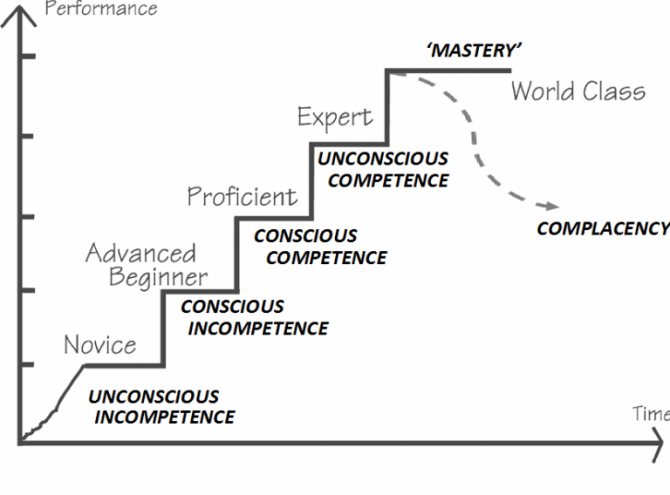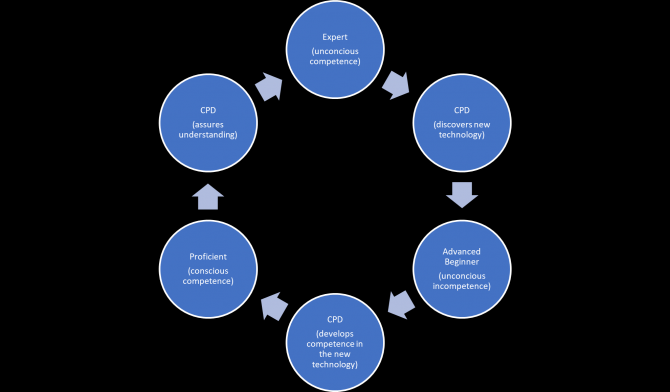Competence and CPD
Competency
One common way we try to understand the different levels of competency is to take from the field of psychology where the four-step model originated illustrating the journey from novice to expert.
Helping engineers understand the benefits from assessing their own competence is best achieved by offering them the time, support and some optional resources to allow them to fill any gaps that they maybe didn’t know were really there until the solutions to fill them were actually made available.

Step 1 – Unconsciously incompetent
You don’t know what you don’t know. You are a beginner.
An example of this would be where a mechanical engineer is offered the opportunity to also train as an electrician. Whilst the individual will have experience of working conditions, they will have no understanding yet on what their learning requirements will be to be recognised as a competent person to a technical level.
Step 2 – Consciously incompetent
You know what you don’t know.
Once the engineer has enrolled and begun the first sessions of training, it will now be more apparent how much learning and development will be involved and what learning area/outcomes will be studies in the future.
Step 3 – Consciously competent
You know what needs to be done and how to do it. You are proficient.
Once the engineer has completed the training journey, it is likely that there will also be a requirement for a competency assessment, such as the AM2 in the electrical industry. At this point the engineer knows what was expected of them, they have been assessed and challenged on their learning and they have been awarded for their achievement.
Step 4 – Unconsciously competent
You are an expert. You perform the task without thought.
Once the engineer has been working in the competent role for a period, a lot of the processes and work behaviour can switch from conscious attempts to work safely to unconscious repetition of work that has been carried out many times before.
It is at this point in step 4 where the engineers not undergoing training, isn’t having to prove their competence to third parties and they can switch off and maybe even go on autopilot. The danger here is that new technologies, new innovations, new regulations, or many other variables could come along that were not within the scope of the initial training. If the engineer has switched off assessing their competence to do the work, then potential dangers may occur.
This is where complacency among a competent work force can result in potential dangers occurring within. A strategy to constantly reassess competence and reflect on their abilities is essential to always have a team of engineers that can work safely and always prevent danger.

It is recommended to introduce a proactive continuing professional development (CPD) strategy. This will help the engineers to start assessing their own competencies, identify opportunities for growth and development and greatly satisfy industry expectations to maintain competence in the workplace.
Continuing professional development (CPD)
*This information on CPD is taken from the institute of Engineering and Technology (IET). It is strongly recommended to consider supporting electricians to apply for membership and seek professional registration.
As the name implies, CPD is with us throughout our careers. It goes beyond professional registration and into retirement, allowing you to stay in touch with developments in engineering. We encourage members to embrace CPD on a daily basis, making it an integral part of your routine.
Qualifications and training levels in the Electrical industry
There are a variety of training routes into the electrical industry, and it can sometimes become confusing determining what qualifications are valid, and for how long? The electrotechnical skills partnership (TESP) was formed to ensure a framework is in place for training and current and new occupations, for entry-level and apprenticeships through to higher-level qualifications.
TESP website - https://www.the-esp.org.uk/
Electrical careers website - https://www.electricalcareers.co.uk/
The following link shows the different industry qualifications for the recommended electrician training routes:
https://www.electricalcareers.co.uk/joining-the-industry/industry-qualifications/
Ofqual
The Office of Qualifications and Examinations Regulation (Ofqual) is the regulator of qualifications, examinations and assessments in England and the regulator of vocational qualifications in Northern Ireland. It is important to remember that all recognised qualifications will meet the strict requirements of what was known as the Regulated Qualification Framework (RQF), previously known as the National Qualifications Framework (NQF), more recently known as Qualifications and Credit Framework (QCF). This means that if you achieve a Level 2 qualification from one Awarding Organisation it will be substantially the same as a qualification in the same field from another Awarding Organisation.
Older qualifications
Many people working in the electrical industry nowadays holds qualifications that are no longer available from awarding organisations. This does not mean that they are obsolete, unacceptable, inferior, or superior, it simply means that they were completed at a different time. Qualifications are designed so that they reflect current industry practices and needs, and you may, therefore, find some modern qualifications containing units on energy efficiency and micro-generation that did not exist in older qualifications. On the other hand, you may find that older qualifications contain some units, such as a unit on the installation of mineral insulated cable, which has not been required to be included in many qualifications for several years.
So how would an electrician update their qualifications? Let’s say that an electrician holds an electrical qualification that they achieved in 1999 and would like to obtain the equivalent current qualification. To do this they would be required to complete the missing units from the 1999 qualification that make up the current qualification. These are normally referred to as ‘bridging units. Once these bridging units have been obtained an application can be made through the college or training provider to the relevant awarding organisation for the current qualification to be awarded. This approach must be agreed with the training provider prior to enrolling on the qualification but is supported by most awarding organisations.
This is another example of where CPD is essential to identify how industry changes over time and to identify if a bridging course is needed to maintain competence.
What counts as CPD?
If you read an article in magazine, watch a relevant programme on the internet or mainstream television, attend a lecture or seminar or give up your time to help young engineers develop, you are undertaking CPD. To make it easier to remember, you can use the acronym TWAVES:
- Training courses
- Work experience
- Academic study
- Volunteering
- Events and seminars
- Self-study
Training
Examples of activities that fall into the category of training courses.
- Soft skills courses
- Technical courses
- E-learning / distance courses
- In-company training courses
- Courses leading to qualifications, e.g. PRINCE2
- Preparing materials for training courses
- Delivering training courses.
Work experience
Examples of activities that fall into the category of work experience.
- Learning by doing the job and developing experience
- Talking to suppliers, customers or specialists and working with them to determine their technical requirements
- Receiving coaching from others
- Secondments and job rotation
- Job shadowing
- Apprenticeships
- Promotion to a new role
- Coaching / training others
- Supervising / managing / leading others
- Presentations to external clients, colleagues, etc
- Preparing and presenting reports
- Managing projects, budgets, teams, etc.
Academic study
Examples of studies that fall into the category of academic study.
- Master’s degree (e.g. MEng, MSc)
- PhD/Doctorate
- Bachelor’s degree (e.g. BEng, BSc)
- Degree apprenticeship
- Foundation Degree (e.g. FD)
- HND
- HNC
- City & Guilds
- NVQ
- ONC
- OND
Volunteering
Examples of activities that fall into the category of volunteering.
- Professional body volunteering roles e.g. mentoring, local network roles, professional registration interviewer, committee roles, etc
- Other volunteer roles that support the development of soft skills/financial/leadership skills e.g. scout/guide leader/school governor, charity work, local organisations, etc
- Speaking at an event
- Membership of a technical expert group.
Events and seminars
Examples of activities that fall into the category of events and seminars.
- Conferences
- Networking events
- Technical visits
- Exhibitions
- Seminars
- Lectures
- Organising meetings or events
- Speaking at an event
- Lecturing or teaching
Self-study
Examples of activities that fall into the category of self-study.
- Reading books, journals and articles
- Research through internet searches and digital information sources
- Online technical communities & discussion forums
- Authoring.
Why bother with CPD?
Undertaking CPD is how you keep up to date with current practice and standards, and it drives you to improve your skills so you can progress into new roles throughout your working life.
CPD will help you:
- achieve your goals efficiently
- keep up with changing technology
- get recognition
- stay in the job market
- develop leadership skills and help influence others
- provide evidence of competence when it’s needed
- demonstrate commitment to your profession.
How much CPD should you complete?
You should try and complete at least 30 hours CPD a year. You can choose how you split your time and the type of activities you do but we recommend doing planned CPD such as training courses and secondments with unplanned CPD such as events and studying at home.
If you’re a retired member who still undertakes engineering-related activities or wants to maintain active knowledge, there’s a reduced requirement of 10 hours CPD annually. However, if you’re active in Committees, Registration and Standards, Accreditation, CPD Monitoring or Mentoring roles, the full 30 hours is required.
A retired or no longer professionally active member isn’t required to undertake CPD. A non-professionally active retired member who is selected for CPD monitoring should simply let us know their circumstances and no further action would be required.
How should you record your CPD?
You need to use an effective system to log your CPD. Professional membership organisations like the IET have their own called Career Manager, but you do not need to use theirs. You will however need to make whatever method you use available for them to check if you were going to apply for membership.
You’ll need to make sure you’ve covered:
- the total number of CPD hours you’ve completed in the previous year
- the type of CPD activity
- a brief reflection on each activity
- a summary of your overall CPD.
How long does it take?
It shouldn’t be time-consuming and it certainly shouldn’t feel like a chore. Whatever system you choose to use, we think it should take you no more than 15 minutes to record your activity and give a brief reflection.
| Action | How often? | How long does it take? |
|---|---|---|
| Register your personal details | Once | 30 minutes |
| Add a job role | Once (with updates) | 30 minutes |
| Add a job role and UK-SPEC objectives | Annually | 30 minutes |
| Create a plan | Annually | 1 hour |
| Record an activity | Monthly (depending on the circumstances) | 5 minutes per activity |
| Reflect | Monthly | 10 minutes per activity |
| Submit a declaration | Annually | 5 minutes |
Do you have to include reflection?
Reflection is an important part of your CPD record as it makes sense to show how the activity you’ve completed has contributed to your professional development. We’re not looking for lengthy reflective statements – you simply need to identify the value of what you did and why you did it. Reflecting when you record your activity also helps you complete your annual return and get the most from your goals.
